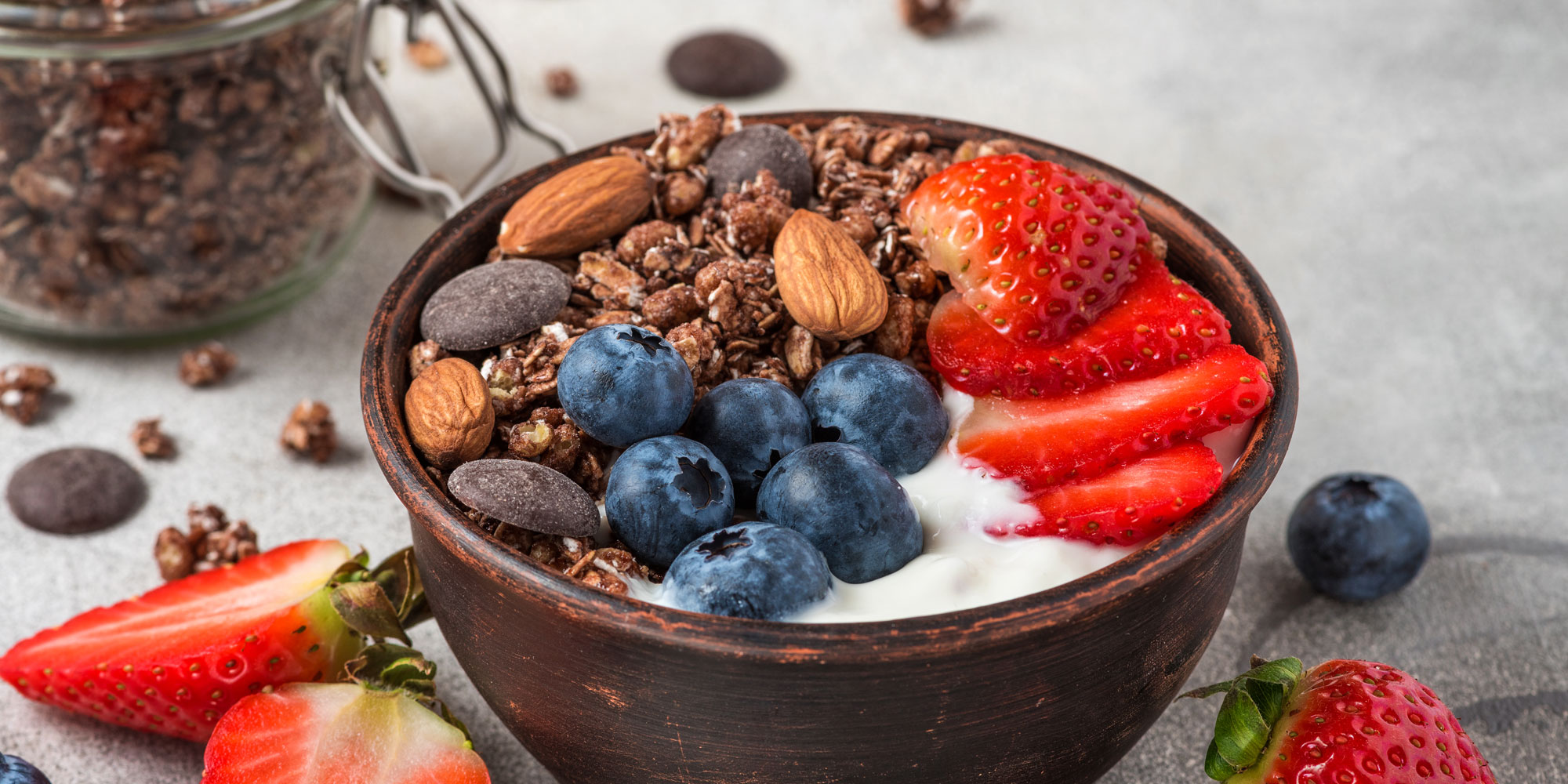By clicking a retailer link you consent to third-party cookies that track your onward journey. This enables W? to receive an affiliate commission if you make a purchase, which supports our mission to be the UK's consumer champion.
High-fibre foods: cheap and easy ways to boost your diet

Most of us don't eat enough high-fibre food, even though it's crucial for our health, from good digestion and feeling satisfied and full, through to helping keep some diseases at bay.
The good news is that boosting your fibre intake doesn’t have to be complicated or costly. We explore simple ways to increase your fibre and look at the social media trend of ‘fibre-maxxing’ — including its potential downsides if you over-do it.
Live well, eat better and stay healthy – sign up to our free monthly Food & Health newsletter
What is fibre and why does it matter?

Dietary fibre is a type of carbohydrate found in plant foods that our bodies can’t digest or absorb. Instead, it passes through the digestive system to the large intestine, where it is broken down by beneficial gut bacteria.
There are several kinds of fibre found in our food: soluble (eg inulin, pectin and beta-glucan), insoluble (e.g. cellulose and lignin) and resistant starch (which isn’t technically a form of fibre, but acts like one).
The benefits of getting enough dietary fibre are well researched and supported by key organisations, including the British Heart Foundation, Cancer Research UK, the World Health Organization and the UK government. Here’s how fibre supports good health:
- Digestive health – helps move food through your digestive system, prevents constipation and feeds 'friendly' gut bacteria.
- Disease prevention – a high-fibre diet is linked to a lower risk of heart disease, stroke, Type 2 diabetes and bowel cancer.
- Feeling fuller for longer – fibre-rich foods can help you feel more satisfied, which can support healthy weight management.
How much fibre do we need?
Adults should have 30g daily and children 15-25g daily, depending on their age (after 16, it's 30g, like adults), according to the 2023 National Diet and Nutrition Survey.
However, UK intake across the board falls below these recommendations, with the average person managing 16-19g of fibre daily, and just 4% of us managing to hit the daily target.
Probiotics and gut health: what you need to know - We look at the evidence for probiotics, cultured yoghurt drinks and other gut health products
What are ‘fibre goals’ and ‘fibremaxxing’?

The terms ‘fibre goals’ and ‘fibremaxxing’ are social media trends focused on increasing daily fibre intake to improve health.
The trend involves intentionally adding more fibre to meals, such as sprinkling seeds on a salad or choosing higher-fibre alternatives. While the benefits of boosting fibre intake are based on fact rather than fad, experts say it’s important to approach it in moderation.
Shefalee Loth, Which? nutritionist, says: ‘A high-fibre diet offers numerous, scientifically supported benefits, including nurturing your gut microbiome, lowering the risk of several diseases and promoting satiety.
‘However, it's important to increase your fibre intake gradually to allow your body to adapt, rather than making sudden, drastic changes which can leave you with unpleasant side effects such as bloating.’
Fibre draws water into the bowel, so it's also essential to stay hydrated while you increase your intake to help prevent constipation.
Do popular diets really work? We assess the evidence behind popular weight loss plans such as keto, paleo and Slimming World
Six easy high-fibre food tips and swaps

It doesn’t take much to edge your fibre intake up towards 30g per day - here are some ways to do it without a dramatic dietary overhaul.
- Pick 'wholegrain' or 'wholemeal'. Look for wholegrain cereals such as Weetabix and All-Bran, wholemeal bread and wraps, and brown rice and pasta over their white counterparts.
- Embrace pulses. Whether it’s tinned baked beans, chickpeas in a curry, or lentils in a soup, pulses are a cheap way to add a lot of fibre. Using canned versions can cut out the hassle.
- Keep the skins on. The skin of fruits and vegetables like potatoes, apples and carrots contains a lot of insoluble fibre.
- Don’t forget frozen. Frozen fruit and veg are often cheaper than fresh but just as fibre-rich. Buy frozen edamame beans to snack on or to add to stir-fries (Morrisons edamame beans, £2.75 for 500g, 55p per 100g).
- Give yourself a fibre-rich treat. Air-popped popcorn is a wholegrain treat that contains 9.3g of fibre per 100g so a 10g serving (around a 330ml mug of popped corn) would give you around 1g of fibre. A few squares of high-cacao dark chocolate (70% or higher) can provide 2-3g of fibre - you could even break them up and put them in a bowl of muesli or other high-fibre cereal.
- Add a 'super-seed' mix. You could buy a plant-based mix such as the Zoe Daily30+ or check out our nutritionist-backed recipe for a DIY version - check out more info on the Zoe Daily30+ supplement: is it worth it and can you make your own instead?
Best fruit and veg boxes UK: top-rated subscriptions and delivery services - we compare boxes from Abel & Cole, Oddbox, Riverford and more
Budget high-fibre meals by a nutrition scientist

Supercharging your daily diet with more fibre doesn't have to be complicated. Here are four simple budget meal options that pack in good fibre levels, rustled up with the help of nutrition scientist Helena Gibson-Moore of the British Nutrition Foundation.
Baked beans on toast: 46p per meal, approx 14.8g fibre
This humble teatime favourite is a powerhouse when it comes to fibre - two slices of wholemeal and a small can of beans provide around half the 30g recommended daily amount of fibre for adults (even more for children). Here's how:
- Sainsbury's baked beans, (30p for small 200g can, 9.3g of fibre)
- Sainsbury's medium sliced wholemeal bread, (75p for 800g, around 16p for two slices. 5.4g of fibre in two slices*)
If you're not a fan of wholemeal, try half and half instead, or for an extra fibre boost plus healthy fats, pick wholemeal with extra grains and seeds (Sainsbury's wholegrain multiseed bread, £1.24 for 430g loaf, 8.2g of fibre per 100g).
Jacket potato with tuna and sweetcorn: £1.36 per meal, approx 9.9g of fibre

This simple spud dish will boost your fibre intake as long as you make sure you eat the potato skin, where much of the fibre is.
- One large potato (Tesco large loose baking potato, 24p, around 7g of fibre - fibre is 3-7g depending on potato size)
- Half a can of sweetcorn (Tesco Natural Sweet Sweetcorn in water, 200g for 49p, 24.5p for half a can, around 2.9g of fibre)
- Half a tin of tuna (Tesco Tuna Chunks In Spring Water, £1.75 for 145g can, 87.5p for half a can - for protein)
What's the most economical way to cook a jacket potato? Putting the oven on for one or two can feel wasteful, but if you plan ahead, you can pop some potatoes in while cooking other meals, or for small batches, cook them using a microwave or air fryer instead. Find out how cooking a baked potato in an air fryer fared with: Air fryer vs oven: energy use, costs and cooking results compared.
Porridge with banana and peanut butter: 25p per meal, approx 8.1g of fibre

Porridge contains decent amounts of fibre, plus you can bump this up with clever topping choices.
- 50g serving of porridge (Asda Everyday Essentials Porridge Oats, 89p for 1kg, 4.5p per 50g serving, around 4.9g of fibre)
- 1 banana (Asda banana, 16p each), around 2g of fibre.
- 1 tablespoon (15g) of crunchy peanut butter (Asda Crunchy Peanut Butter, 99p for 340g, 4.5p per 15g, around 1.2g of fibre)
Other good fibre-rich toppings include raspberries (50g of frozen raspberries contain 3.4g of fibre), grated apple with its skin (2g of fibre) or a topping of walnuts and almonds (4g of fibre per large handful of 40-50g).
Best multivitamin supplements 2025 - We've assessed supplements from brands including Boots, Centrum, Holland & Barrett and Seven Seas to uncover the best
Supermarket meal deal stir-fry: £3.50 per serving, approx 7.9g fibre

Supermarket stir-fry meal deals typically include vegetables, a protein ingredient such as chicken or tofu, plus rice or noodles and a sauce for around £6 to £8 (feeds two). As an example, with Waitrose's £7 stir-fry Dine In deal for two, you can choose:
- Waitrose Bright and Colourful Ginger stir fry, (2.2g fibre per 50g half pack serving)
- Waitrose rice, quinoa & vegetables (5.7g of fibre in 150g serving)
How to pack more fibre into your stir fry

- Choose a rainbow vegetable mix. A bag containing a range of different veg like carrots, broccoli and greens such as pak choi is better for fibre (and other nutrients) than a bag of just beansprouts.
- Bump up fibre levels with fridge and freezer basics. Use up what you have in the fridge, such as broccoli florets or carrot batons, or add in frozen veg such as a 3 tbsp serving (80g) of frozen peas.
- Opt for veggie protein. Unlike animal protein sources, foods such as tofu also contain fibre.
- Pick a higher fibre carb. Brown rice and quinoa are higher in fibre than white rice noodles.
Best magnesium supplements 2025 - we've reviewed magnesium supplements from brands including Boots, Holland & Barrett, Nutrition Geeks, Vitabiotics and more to uncover the best
How to eat a high-fibre diet that's also lower in carbs
People sometimes follow low carbohydrate (low-carb) diet for helping to control blood sugar levels, for example if they have type 2 diabetes, but this doesn't mean no carb foods at all because some are rich in nutrients and high in fibre.
A low-carb diet means consuming no more than 130g of carbohydrates a day - you can do this safely by reducing refined carb intake from foods including cakes, biscuits and sugary drinks (including fruit juices), and focusing on low-carb, high-fibre foods such as these instead:
Non-starchy veg: For example, avocado, broccoli, cauliflower, spinach, asparagus, kale and mushrooms. Salad is also a good choice, as well as pulses such as chickpeas.
Nuts and seeds: Chia seeds, flaxseeds, almonds, walnuts and pumpkin seeds. Even a small serving packs a punch - for example, chia seeds have roughly 4.8g or fibre per tablespoon.
Berries: Raspberries, blackberries, strawberries and blueberries are all high in soluble fibre.
*NB. Supermarket examples chosen based on price and factoring in top-performing budget options from our food and drink taste tests. Similar budget options will be available at most supermarkets. Fibre levels as stated on pack and will vary slightly by supermarket/product.




